Multi-Axis Flexure Stage Accessories: Fiber Chucks and Mounts
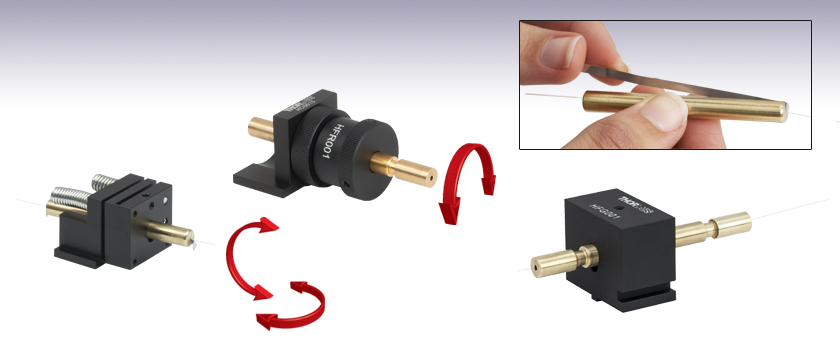
- Side or Rear-Loading Ø0.25" (Ø6.4 mm) Fiber Chucks
- Fiber Chuck Mounts with 3 mm Alignment Groove
- Polarization-Maintaining, Pitch/Yaw,
or Rotation Mounts
HGF003
Fiber Chuck Pitch
& Yaw Mount (Chuck not Included)
Pitch
Yaw
±3°
HFR001
Fiber Chuck Rotation Mount Secured into a Fixed Mount
(Chuck and Fixed Mount not Included)
HFC005
Standard 1/4"
Fiber Chuck
HFG001
Fiber Chuck
Mount (Chuck not Included)
HFC007
Side-Loading
Fiber Chuck

Please Wait
| Other Bare Fiber Mounts | ||||
|---|---|---|---|---|
| Post Mountable or SM Threaded |
Post Mountable with Vacuum Port |
Flexure Stage Compatible | ||
| V-Mounts | Fiber Block | Clamps | Chucks | Rotators |
Features
- Ø1/4" (Ø6.4 mm) Fiber Chucks Accept Stripped Fibers up to Ø200 µm
- Fiber Chuck Mounts Feature 3 mm Alignment Grooves for Flexure Stage Mounting
- Several Mounting Options: Polarization-Maintaining, Pitch/Yaw, or Rotation
Fiber chucks are designed to conveniently mount bare optical fibers into optical systems. On this page, we offer Ø1/4" fiber chucks that accept fibers with diameters up to 200 µm without a coating. In addition, we offer fiber chuck holders and mounts that accept industry-standard fiber chucks, allowing them to be mounted on one of our multi-axis flexure stages using AMA010(/M) cleats as sold below.
| Table 1.1 Multi-Axis Stage Accessories | |||||||||||
|---|---|---|---|---|---|---|---|---|---|---|---|
 |
 |
 |
 |
 |
 |
 |
 |
 |
 |
 |
 |
| Fiber Mounts |
Fiber Rotators |
Waveguide Mounts |
Diode Mounts |
Fixed Mounts |
Kinematic Mounts |
Top Plates |
Extension Platforms |
Fiber Chucks |
Slide Holders |
Kinematic Platforms |
Adapter Plates |
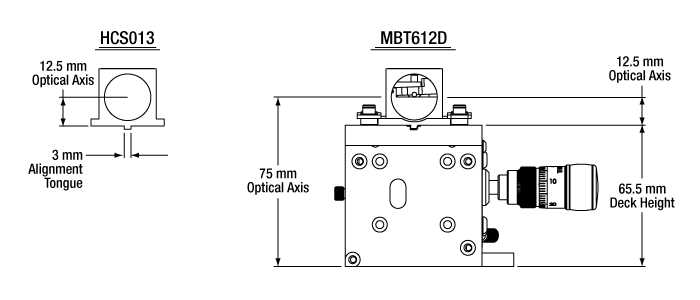
Deck Height is the distance from the base of the mounting surface of an optical table or breadboard to the top mounting surface of the stage. There are two standard deck heights: 62.5mm for the MBT, RollerBlock, and Max300 series stages or 112.5mm deck height for the Max600 and NBM series stages. A wide range of riser blocks and plates are available to accommodate for variations when stacking stages on top of each other.
Optical Axis, also referred to as Beam Height, is the nominal height at which the beam should pass over the stage and through a given optical component or device. There are two standard optical axis heights: 75mm for the MBT, RollerBlock, and Max300 series stages or 125mm deck height for the Max600 and NBM series stages. Most standard accessories use a 12.5mm optical axis/beam height.
Insights into Optical Fiber
Scroll down to read about:
- What factors affect the amount of light coupled into a single mode fiber?
- Is the max acceptance angle constant across the core of a multimode fiber?
Click here for more insights into lab practices and equipment.
What factors affect the amount of light coupled into a single mode fiber?
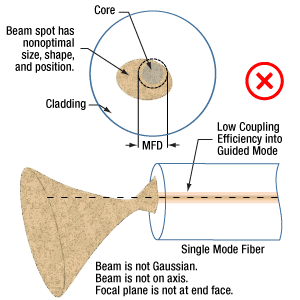
Click to Enlarge
Figure 193B Conditions which can reduce coupling efficiency into single mode fibers include anything that reduces the similarity of the incident beam to the optical properties of the fiber's guided mode.
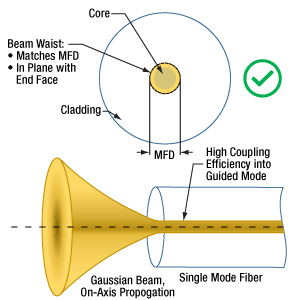
Click to Enlarge
Figure 193A For maximum coupling efficiency into single mode fibers, the light should be an on-axis Gaussian beam with its waist located at the fiber's end face, and the waist diameter should equal the MFD.
Adjusting the incident beam's angle, position, and intensity profile can improve the coupling efficiency of light into a single mode optical fiber. Assuming the fiber's end face is planar and perpendicular to the fiber's long axis, coupling efficiency is optimized for beams meeting the following criteria (Figure 193A):
- Gaussian intensity profile.
- Normal incidence on the fiber's end face.
- Beam waist in the plane of the end face.
- Beam waist centered on the fiber's core.
- Diameter of the beam waist equal to the mode field diameter (MFD) of the fiber.
Deviations from these ideal coupling conditions are illustrated in Figure 193B.
These beam properties follow from wave optics analysis of a single mode fiber's guided mode (Kowalevicz).
The Light Source can Limit Coupling Efficiency
Lasers emitting only the lowest-order transverse mode provide beams with near-Gaussian profiles, which can be efficiently coupled into single mode fibers.
The coupling efficiency of light from multimode lasers or broadband light sources into the guided mode of a single mode fiber will be poor, even if the light is focused on the core region of the end face. Most of the light from these sources will leak out of the fiber.
The poor coupling efficiency is due to only a fraction of the light in these multimode sources matching the characteristics of the single mode fiber's guided mode. By spatially filtering the light from the source, the amount of light that may be coupled into the fiber's core can be estimated. At best, a single mode fiber will accept only the light in the Gaussian beam output by the filter.
The coupling efficiency of light from a multimode source into a fiber's core can be improved if a multimode fiber is used instead of a single mode fiber.
References
Kowalevicz A and Bucholtz F, "Beam Divergence from an SMF-28 Optical Fiber (NRL/MR/5650--06-8996)." Naval Research Laboratory, 2006.
Date of Last Edit: Jan. 17, 2020
Is the max acceptance angle constant across the core of a multimode fiber?
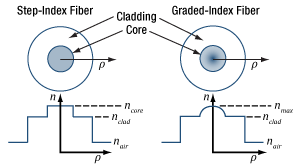
Click to Enlarge
Figure 193C Step-index multimode fibers have an index of refraction ( n ) that is constant across the core. Graded-index multimode fibers have an index that varies across the core. Typically the maximum index occurs at the center.
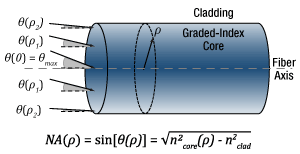
Click to Enlarge
Figure 193E Graded-index multimode fibers have acceptance angles that vary with radius ( ρ ), since the refractive index of the core varies with radius. The largest acceptance angles typically occur near the center, and the smallest, which approach 0°, occur near the boundary with the cladding
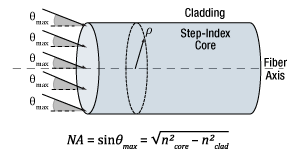
Click to Enlarge
Figure 193D Step-index multimode fibers accept light incident in the core at angles ≤|θmax | with good coupling efficiency. The maximum acceptance angle is constant across the core's radius ( ρ ). Air is assumed to surround the fiber.
It depends on the type of fiber. A step-index multimode fiber provides the same maximum acceptance angle at every position across the fiber's core. Graded-index multimode fibers, in contrast, accept rays with the largest range of incident angles only at the core's center. The maximum acceptance angle decreases with distance from the center and approaches 0° near the interface with the cladding.
Step-Index Multimode Fiber
The core of a step-index multimode fiber has a flat-top index profile, which is illustrated on the left side of Figure 193C. When light is coupled into the planar end face of the fiber, the maximum acceptance angle (θmax ) is the same at every location across the core (Figure 193D). This is due to the constant value of refractive index across the core, since the acceptance angle depends strongly on the index of the cladding.
Regardless of whether rays are incident near the center or edge of the core, step-index multimode fibers will accept cones of rays spanning angles ±θmax with respect to the fiber's axis.
Graded-Index Multimode Fibers
The core of a typical graded-index multimode fiber, shown on the right side of Figure 193C, has a refractive index that is greatest at the center of the core and decreases with radial distance ( ρ ). The equation included below the diagram in Figure 193E shows that the radial dependence of the core's refractive index results in a radial dependence of the maximum acceptance angle and numerical aperture (NA). This equation also assumes a planar end face, normal to the fiber's axis that is surrounded by air.
Cones of rays with angular ranges limited by the core's refractive index profile are illustrated Figure 193E. The cone of rays with the largest angular spread
Step-Index or Graded Index?
A step-index multimode fiber has the potential to collect more light than a graded-index multimode fiber. This is due to the NA being constant across the step-index core, while the NA decreases with radial distance across the graded-index core.
However, the graded-index profile causes all of the guided modes to have similar propagation velocities, which reduces the modal dispersion of the light beam as it travels in the fiber.
For applications that rely on coupling as much light as possible into the multimode fiber and are less sensitive to modal dispersion, a step-index multimode fiber may be the better choice. If the reverse is true, a graded-index multimode fiber should be considered.
References
Keiser G, "Section 2.6." Optical Fiber Communications. McGraw-Hill, 1991.
Date of Last Edit: Jan. 2, 2019
| Posted Comments: | |
Tyler
(posted 2008-09-17 16:52:00.0) A response from Tyler at Thorlabs to jmills: Thank you for the excellent suggestion. The text has been reordered so that the description is more inline with the correct picture. jmills
(posted 2008-09-17 13:22:56.0) Swapping the pictures on the overview tab would make the presentation easier to digest. Right now the text describes the side loading chuck first and the back loading fiber chuck second but the pictures right next to the text are opposite. |

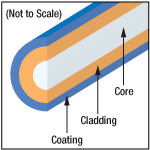
Click to Enlarge
Figure G1.1 Basic Structure of a Typical Optical Fiber
- Ø1/4" (Ø6.4 mm) Fiber Chucks
- Accepts Stripped Fiber up to Ø200 µm
- Back-Loading and Side-Loading Versions
Thorlabs' Ø1/4" Fiber Chucks are designed to accept fibers with diameters up to 200 µm once the coating (buffer) has been stripped. However, it will have a more secure hold on fibers that are closer to Ø200 µm. The HFC005 is a standard fiber chuck that is loaded from the back. The fiber is fed through the length of the chuck and then a collet mechanism is used to secure the fiber in place. Therefore, the fiber needs to be stripped and fed through the holder prior to being cleaved to prevent damage to the fiber endface. This fiber chuck is ideal for use with the HFR001 Rotator or HFP001 Polarization-Maintaining Mount presented below. The HFC005 chuck measures 2.77" (70 mm) in length and has a diameter of Ø0.25" (Ø6.4 mm).
The HFC007 Side-Loading Fiber Chuck is loaded from the side, which makes it possible to cleave the fiber prior to loading. A spring clip secures the fiber in place within the chuck, but does not provide a sufficient clamping force to keep the fiber from rotating. Therefore, this chuck should not be placed inside a rotator such as the HFR001 or used with the HFP001 polarization-maintaining fiber chuck holder. The HFC007 chuck measures 2.36" (60 mm) in length and has a diameter of Ø0.25" (Ø6.4 mm).
Fiber should be stripped of the coating prior to use with these fiber chucks. Figure G1.1 shows the structure of a typical fiber consisting of a core, cladding, and coating (not to scale). The coating, sometimes also referred to as a buffer, serves to protect the cladding of glass fibers from particulates that may land on the surface of the fiber. The coating of certain specialized fibers can have optical properties that allow it to act as a second cladding layer. In these cases, the optical properties of the fiber should be considered before stripping off the coating layer.
We also offer an array of bare fiber clamps and a rotator for Fiber Launch platforms, as well as other Fiber Optomechanics; please see Table 1.1 for details.

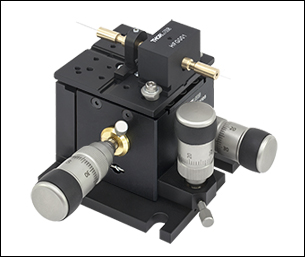
Click to Enlarge
Figure G2.1 HFC005 Fiber Chuck in HFG001 and HFP001 Mounts on a Three-Axis Flexure Stage
- Mount Ø1/4" (Ø6.4 mm) Fiber Chucks on a Flexure Stage
- HFP001 Preserves Rotational Fiber Alignment in the HFG001
Thorlabs' Fiber Chuck Holders are designed to accept industry-standard fiber chucks and mount them on one of our multi-axis flexure stages using AMA010 cleats. The HFG001 features a double bore that ensures two lines of contact are maintained along the length of the Ø1/4" chuck. A nylon-tipped set screw (1.5 mm hex) is used to apply the pressure required to firmly hold the fiber chuck in place.
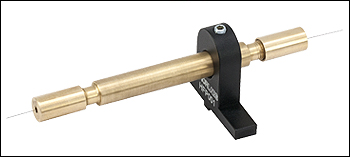
Click to Enlarge
Figure G2.2 The HFP001 Preserves the Rotational Alignment of the Fiber When the Chuck is Removed from the HFG001.
The HFP001 Polarization-Maintaining Fiber Chuck Holder is designed to maintain the rotational alignment of a fiber chuck, and therefore maintain the polarization of the light from the fiber. To do so, the HFP001 is used together with the HFG001 Mounting block described above (see Figure G2.1). A fiber chuck is secured in both the HFG001 and the HFP001 with nylon-tipped setscrews (using a 1.5 mm hex) and the HFP001 is aligned with the 3 mm groove on the flexure stage. The fiber chuck can then be removed by releasing it only from the HFG001 mounting block, leaving the chuck in the HFP001 (as shown in Figure G2.2). During refitting, The HFP001 is simply realigned with the same 3 mm groove and the fiber's rotational alignment is preserved. Throughout this process, the fiber in the chuck should not be rotated with respect to the HFP001 if the polarization of the light is to be maintained.
We also offer an array of bare fiber clamps and a rotator for Fiber Launch platforms, as well as other Fiber Optomechanics; please see Table 1.1 for details.

Video G3.1 HFG003 Fiber Chuck Usage
- Flexure Pitch and Yaw Fiber Chuck Holder
- ±3° Pitch and Yaw Adjustable via Back Plate Adjuster Screws
The HFG003 Flexure Mount provides ±3° of pitch and yaw adjustment and is designed to accept our 1/4" diameter fiber chucks (HFC005 and HFC007). This adjustable fiber chuck mount can be mounted to our multi-axis flexure stages using AMA010 cleats. A nylon-tipped set screw (1.5 mm hex) is used to apply the pressure required to firmly hold the fiber chuck in place. As seen in Video G3.1, the pitch and yaw can be adjusted using a 1.5 mm hex key.
When working with low numerical aperture (NA) optical fibers, the angular adjustment of the optical fiber with respect to the incoming laser beam can be critical to optimizing the coupling efficiency. Additionally, if small core fibers are being used, the high divergence angle of tightly focused laser beams can also require careful angular alignment to ensure the input NA of the fiber is not exceeded.

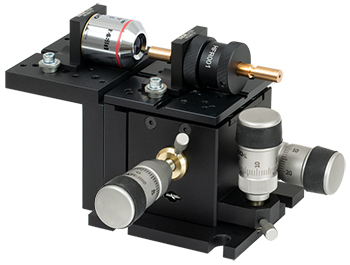
Click to Enlarge
Figure G4.1 HFR001 Fiber Chuck Rotator in a Fiber Launch Setup Mounted on a MBT616D Flexure Stage
| Specification | Value |
|---|---|
| Rotation Range | 360° |
| Maximum Eccentricity | <20 µm |
| Mounting Thread | RMS |
| Compatible Objective Mounts | HCS013 |
- Smooth, Low-Friction Fiber Rotator
- Designed for 1/4" Fiber Chucks
- RMS-Threaded (0.800"-36) Mounting Feature Enables Incorporation into Existing Mounts
- Three M3 Nylon-Tipped Set Screws Secure the Fiber Chuck
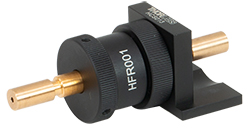 Click to Enlarge
Click to EnlargeFigure G4.2 The HFR001 is mounted to a HCS013 flexure stage mount to secure a HFC005 fiber chuck.
The HFR001 Fiber Chuck Rotator is designed to hold a standard Ø1/4" fiber chuck such as the HFC005 presented in Figure G4.2 and allow continuous rotation through 360°. The fiber chuck is secured by tightening the M3 nylon-tipped set screws with a 1.5 mm hex key. The HFR001 has a male RMS thread (0.800"-36) for attachment to an HCS013 RMS-threaded flexure stage mount, which can then be secured to the top plate of one of our multi-axis flexure stages or fixed brackets. The phosphor-bronze and PTFE bearing in the fiber chuck rotator provides smooth, low-friction rotation for precise angular orientation of a polarization-maintaining fiber. The lateral offset during rotation is typically less than 20 µm; this relatively small offset allows a fiber to be rotated by about 90° before requiring compensation with y and z adjustments of the stage. This combination provides 360° of initial fiber rotation with 8° of ultra-fine rotation.
Figure G4.1 shows a typical application. The HFR001 is held in an HCS013 RMS-threaded flexure stage mount and mounted to a 3-Axis Flexure Stage. The fiber chuck rotator holds the fiber, whose output is aligned with the microscope objective, which is fitted to the objective holder and mounted on a fixed bracket. The HFR001 can also be used with the roll/pitch platform (e.g., AMA027) to launch light into polarization-maintaining fibers.
Please note that the HFC007 fiber chuck featured above should not be used with the HFR001 fiber rotator, as it does not provide sufficient clamping force to prevent rotation of the fiber once placed inside the rotator.

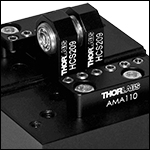
Click for Details
Figure 210B Accessories mounted in close proximity using the AMA110 Mounting Block.
- Secures Components to NanoMax, MicroBlock, or RollerBlock Stages
- Cleats for Mounting Single Components
- Mounting Blocks and Clamps for Close Proximity Mounting of Multiple Components
The AMA010(/M) Cleats have a flat milled along one side. To lock an accessory along the center alignment groove, rotate the cleat so that the flat is facing the groove. Place the accessory into the groove between the cleats, rotate the cleat so that the rounded edge covers the edge of the mount, and lock down the 6-32 (M3) locking screw and washer. The cleats can be rotated without needing to remove the locking screws. See Video 210A for details. The included screws are 5/16" (8 mm) long and are used with a 3/32" (2.5 mm) hex key.
For mounting multiple components in close proximity, we offer the AMA110 mounting blocks. These mounting blocks feature a line of nylon-tipped setscrews to secure components, and allow for easy repositioning and very close mounting. The blocks are secured via two holes and are supplied with either 6-32 or M3 cap screws.
The AMA111 Narrow Device Mounting Clamps offer an alternative solution when devices need to be mounted close together. They are secured using an M3.5 or M3 washer and a 6-32 or M3 cap screw, compatible with a 7/64" or 2.5 mm hex key, respectively.
 Products Home
Products Home









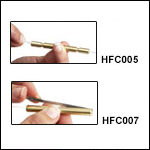
 Zoom
Zoom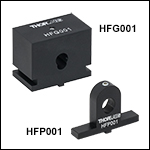
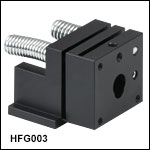
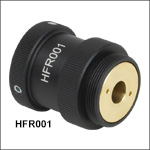
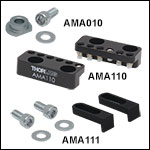
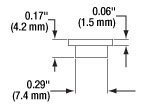


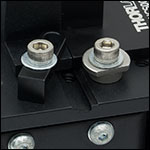
 Fiber Chucks and Adapters
Fiber Chucks and Adapters